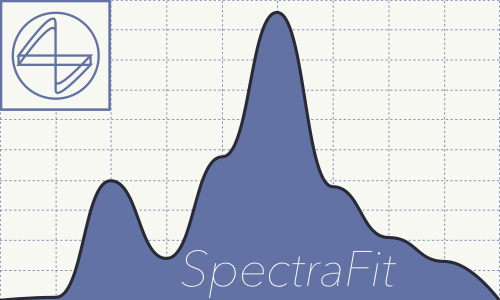Fast fitting of 2D-Spectra with established routines
Project description

SpectraFit
SpectraFit is a command line tool for quick data fitting based on the regular
expression of distribution and linear functions. Furthermore, it can be also
used as a module in existing python code. A previous version of SpectraFit was
used for the following publication:
Now, it is completely rewritten and is more flexible. It is supporting all
common ASCII-data formats and it run on Linux, Windows, and MacOS.
Scope
- Fitting of 2D data
- Using established and advanced solver methods
- Extensibility of the fitting function
- Guarantee traceability of the fitting results
- Saving all results in a SQL-like-format (
CSV) for publications - Saving all results in a NoSQL-like-format (
JSON) for project management - Having an API interface for Graph-databases
Installation
via pip:
pip install spectrafit
# Upgrade
pip install spectrafit --upgrade
Usage
SpectraFit needs as command line tool only two things:
- The reference data, which should be fitted.
- The input file, which contains the initial model.
As model files json,
toml, and
yaml are supported. By making use of the
python **kwargs feature, the input file can call most of the following
functions of LMFIT. LMFIT is the
workhorse for the fit optimization, which is macro wrapper based on:
In case of SpectraFit, we have further extend the package by:
- Pandas
- statsmodels
- numdifftools
- Matplotlib in combination with Seaborn
spectrafit data_file.txt -i input_file.json
usage: spectrafit [-h] [-o OUTFILE] [-i INPUT] [-ov] [-e0 ENERGY_START]
[-e1 ENERGY_STOP] [-s SMOOTH] [-sh SHIFT] [-c COLUMN COLUMN]
[-sep { ,,,;,:,|, ,s+}] [-dec {.,,}] [-hd HEADER]
[-g {0,1,2}] [-auto] [-np] [-v] [-vb {0,1,2}]
infile
Fast Fitting Program for ascii txt files.
positional arguments:
infile Filename of the spectra data
optional arguments:
-h, --help show this help message and exit
-o OUTFILE, --outfile OUTFILE
Filename for the export, default to set to
'spectrafit_results'.
-i INPUT, --input INPUT
Filename for the input parameter, default to set to
'fitting_input.toml'.Supported fileformats are:
'*.json', '*.yml', '*.yaml', and '*.toml'
-ov, --oversampling Oversampling the spectra by using factor of 5;
default to False.
-e0 ENERGY_START, --energy_start ENERGY_START
Starting energy in eV; default to start of energy.
-e1 ENERGY_STOP, --energy_stop ENERGY_STOP
Ending energy in eV; default to end of energy.
-s SMOOTH, --smooth SMOOTH
Number of smooth points for lmfit; default to 0.
-sh SHIFT, --shift SHIFT
Constant applied energy shift; default to 0.0.
-c COLUMN COLUMN, --column COLUMN COLUMN
Selected columns for the energy- and intensity-values;
default to '0' for energy (x-axis) and '1' for intensity
(y-axis). In case of working with header, the column
should be set to the column names as 'str'; default
to 0 and 1.
-sep { ,,,;,:,|, ,s+}, --separator { ,,,;,:,|, ,s+}
Redefine the type of separator; default to ' '.
-dec {.,,}, --decimal {.,,}
Type of decimal separator; default to '.'.
-hd HEADER, --header HEADER
Selected the header for the dataframe; default to None.
-g {0,1,2}, --global {0,1,2}
Perform a global fit over the complete dataframe. The
options are '0' for classic fit (default). The
option '1' for global fitting with auto-definition
of the peaks depending on the column size and '2'
for self-defined global fitting routines.
-auto, --autopeak Auto detection of peaks in the spectra based on `SciPy`.
The position, height, and width are used as estimation
for the `Gaussian` models.The default option is 'False'
for manual peak definition.
-np, --noplot No plotting the spectra and the fit of `SpectraFit`.
-v, --version Display the current version of `SpectraFit`.
-vb {0,1,2}, --verbose {0,1,2}
Display the initial configuration parameters and fit
results, as a table '1', as a dictionary '2', or not in
the terminal '0'. The default option is set to 1 for
table `printout`.
Documentation
Please see the extended documentation
for the full usage of SpectraFit.
Project details
Release history Release notifications | RSS feed
Download files
Download the file for your platform. If you're not sure which to choose, learn more about installing packages.
Source Distribution
Built Distribution
Hashes for SpectraFit-0.8.1-py3-none-any.whl
| Algorithm | Hash digest | |
|---|---|---|
| SHA256 | 608b20321cbffa792f21a64d7008254646201b8d7c08f6ad3f46981c399f1e15 |
|
| MD5 | 7f9fb501d056ebb8f32e52a8f44b130c |
|
| BLAKE2b-256 | 9778aac9ecad599477b150f1a2c43da6f5ba834adfdc43afe52151684766ae4d |
















